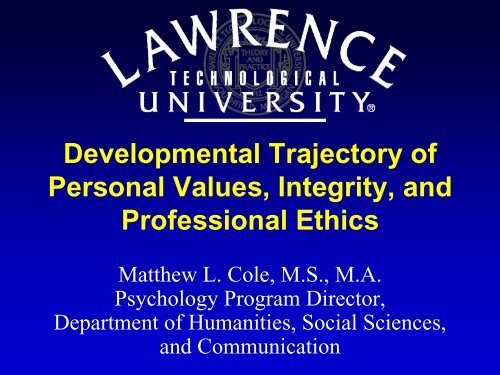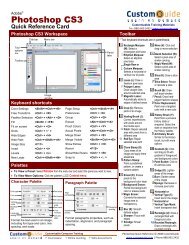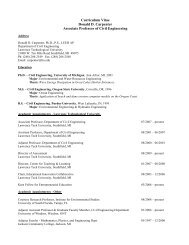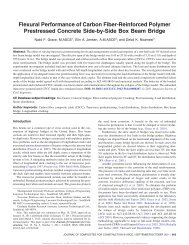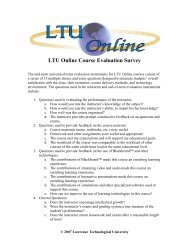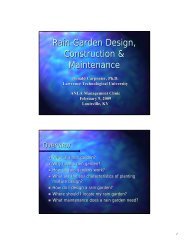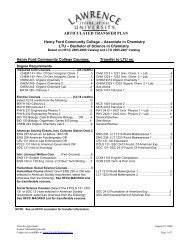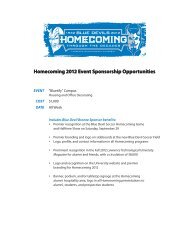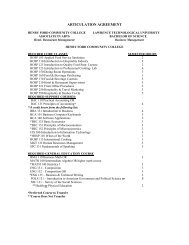Development Trajectory of Personal Values, Integrity, and
Development Trajectory of Personal Values, Integrity, and
Development Trajectory of Personal Values, Integrity, and
- No tags were found...
Create successful ePaper yourself
Turn your PDF publications into a flip-book with our unique Google optimized e-Paper software.
<strong>Development</strong>al <strong>Trajectory</strong> <strong>of</strong><strong>Personal</strong> <strong>Values</strong>, <strong>Integrity</strong>, <strong>and</strong>Pr<strong>of</strong>essional EthicsMatthew L. Cole, M.S., M.A.Psychology Program Director,Department <strong>of</strong> Humanities, Social Sciences,<strong>and</strong> Communication
Overview• What is sociomoral development <strong>and</strong> how is itrelated to personal values, integrity <strong>and</strong> ethics?• What are the developmental trends in sociomoraldevelopment?• What are some <strong>of</strong> the ways in which faculty canintroduce character education into the classroomcurriculum in order to help shape students tobecome “morally serious people”?
AAC&U Greater ExpectationsReport (2002)• The Association <strong>of</strong> American Colleges <strong>and</strong>Universities concept <strong>of</strong> “responsible learners”– Students who “appreciate others, while alsoassuming accountability for themselves, theircomplex identities, <strong>and</strong> their conduct.”– “By weaving moral reasoning into the social fabric<strong>of</strong> life <strong>and</strong> work, they help society shape its ethicalvalues, <strong>and</strong> then live by those values” (p.23).
Sociomoral <strong>Development</strong>
Sociomoral <strong>Development</strong>• Morals = principles <strong>of</strong> right <strong>and</strong> wrong behavior• Ethics = the discipline dealing with what is good<strong>and</strong> bad <strong>and</strong> with moral duty <strong>and</strong> obligation• Ethics reflect the cultural values <strong>and</strong> mores <strong>of</strong> thesociety in which they are formulated.• Ethics address in one way or another the issues <strong>of</strong>respect, rights, confidentiality, informed consent,diversity, well-being <strong>of</strong> consumers, competency,pr<strong>of</strong>essional boundaries, conflict <strong>of</strong> interest,honesty, <strong>and</strong> responsibility to society.
Sociomoral <strong>Development</strong>• Sociomoral development refers to the growingcapacity to relate emotionally, ethically, <strong>and</strong>intellectually to the external world.• Encompasses social <strong>and</strong> personal development.• Refers to age-appropriate cognitive capacities toperceive, wrestle with, <strong>and</strong> logically resolve thecomplexities <strong>of</strong> the moral aspects <strong>of</strong> life <strong>and</strong>real-life moral contexts.
Components <strong>of</strong> Sociomoral<strong>Development</strong>
Components <strong>of</strong> Sociomoral<strong>Development</strong>: Identity• Sociomoral development begins with knowingone’s self.• We must know what is important to us, what ourworldview is, <strong>and</strong> how our culturalbackgrounds, personal histories <strong>and</strong> personalvalues influence that worldview.• How we view the world <strong>and</strong> ourselves within itshapes our responses to choices <strong>and</strong> decisionsthat confront us.
Components <strong>of</strong> Sociomoral<strong>Development</strong>: Relationship• Sociomoral development involves learningabout relationships between self <strong>and</strong> others.• How will my action impact someone else <strong>and</strong>why should I care about that impact?• Exploring how we interact with others <strong>and</strong> ourbeliefs about the value <strong>of</strong> those interactions is anessential component <strong>of</strong> promoting ethicaldevelopment.
Components <strong>of</strong> Sociomoral<strong>Development</strong>: Accountability• Ethical decisions <strong>and</strong> behaviors impact largerwholes beyond the individual, in what may betermed civic responsibility.• Families, communities, organizations,institutions, corporations, <strong>and</strong> nations can beeither positively or negatively impacted by theactions <strong>of</strong> individuals.• Sociomoral development must include theconcepts <strong>of</strong> accountability <strong>and</strong> responsibility.
Chickering’s Model <strong>of</strong>Sociomoral <strong>Development</strong>• Based on Eric Erikson's developmentaltheory, Kohlberg’s <strong>and</strong> Gilligan’s theories <strong>of</strong>moral development, <strong>and</strong> Eisenberg’stheoretical perspective on prosocial behavior• Chickering proposed seven vectors <strong>of</strong>sociomoral development that align with thedevelopment <strong>of</strong> traditional-aged collegestudents.
Chickering’s Model <strong>of</strong>Sociomoral <strong>Development</strong>1. Developing Competence2. Managing Emotions3. Developing Autonomy4. Establishing Identity5. Developing Interpersonal Relationships6. Developing Purpose7. Developing <strong>Integrity</strong>
1. Developing Competence• Intellectual competence– knowledge acquisition & critical thinkingskills– capacity for analysis, synthesis, evaluation, &creation <strong>of</strong> ideas• Physical <strong>and</strong> manual competence– Athletic <strong>and</strong> artistic achievement• Social/interpersonal competence– Listen, cooperate, communicate
2. Managing Emotions• Increasing awareness <strong>of</strong> one's feelings– aware <strong>of</strong> range <strong>and</strong> variety <strong>of</strong> impulses– integration <strong>of</strong> feelings, which allows flexiblecontrol <strong>and</strong> expression– tries to find new modes <strong>of</strong> expression– assess consequences– know how to h<strong>and</strong>le different feelings– define what will be expressed to whom
3. Developing Autonomy• At this stage, students develop increasedemotional independence, self-direction,problem-solving ability, persistence, <strong>and</strong>mobility• Students recognize <strong>and</strong> accept theimportance <strong>of</strong> interdependence.
4. Establishing Identity• A positive identity includes– comfort with body <strong>and</strong> appearance– comfort with gender <strong>and</strong> sexual orientation– a sense <strong>of</strong> one’s social <strong>and</strong> cultural heritage– a clear concept <strong>of</strong> self <strong>and</strong> comfort with one’s roles<strong>and</strong> lifestyle– a secure sense <strong>of</strong> self in light <strong>of</strong> feedback fromsignificant others– self-acceptance <strong>and</strong> self-esteem– personal stability <strong>and</strong> integration
5. Developing InterpersonalRelationships• Increased tolerance for <strong>and</strong> acceptance <strong>of</strong>differences between individuals• Increased capacity for mature <strong>and</strong> intimaterelationships• More reciprocal <strong>and</strong> empathetic
6. Developing Purpose• This vector consists <strong>of</strong> developing clearvocational goals, making meaningfulcommitments to specific personal interests <strong>and</strong>activities, <strong>and</strong> establishing strong interpersonalcommitments.• Direction for one's life through assessment <strong>and</strong>clarification <strong>of</strong> interests, educational <strong>and</strong> careeroptions, <strong>and</strong> lifestyle preferences• Integrated with sense <strong>of</strong> identity
7. Developing <strong>Integrity</strong>• Students progress from rigid, moralistic thinkingto a more humanized, personalized value systemthat acknowledges <strong>and</strong> respects the beliefs <strong>of</strong>others. <strong>Values</strong> <strong>and</strong> actions become congruent.• Defining set <strong>of</strong> values to guide actions– humanizing <strong>of</strong> values• Shift from literal doctrine set <strong>of</strong> beliefs toawareness <strong>of</strong> relativity <strong>of</strong> values– personalizing <strong>of</strong> values
7. Developing <strong>Integrity</strong>• <strong>Personal</strong> code -personal assessment &direction serving as guide to behavior– congruence between beliefs <strong>and</strong> behavior• Congruence between values <strong>and</strong> actions• Viewing values from post-conventionallevel <strong>of</strong> morality (Kohlberg’s final stage<strong>of</strong> moral development—guided byuniversal moral principles, not the laws <strong>of</strong>society)
<strong>Development</strong>al <strong>Trajectory</strong>Through Vectors• Chickering posits that students progressthrough the first three vectorssimultaneously during the freshman <strong>and</strong>sophomore years.• Students generally progress through thefourth vector during their sophomore <strong>and</strong>junior years.• Students progress through the last threevectors simultaneously during their junior<strong>and</strong> senior years.
Vectors <strong>and</strong> Social Norms• Chickering's vectors depend largely onsocial norms.• Vectors are dynamic since social valueschange through time.• Social values are different around the world.• Closely aligned with Dewey’s progressivistapproach to education—moral developmentis impacted by the social culture <strong>of</strong> schools
Character Education• Character education has been a vital part <strong>of</strong>US school curricula.• In 1901, the National Education Associationendorsed character training in the schools.• “The fundamental consideration in anysystem <strong>of</strong> schools is the development <strong>of</strong>moral character”.
Maryl<strong>and</strong> Value EducationCommission Character Objectives1. <strong>Personal</strong> integrity <strong>and</strong> honesty rooted inrespect for the truth, intellectual curiostiy,<strong>and</strong> love <strong>of</strong> learning2. A sense <strong>of</strong> duty to self, family, school, <strong>and</strong>community3. Self-esteem rooted in the recognition <strong>of</strong>one’s potential
Maryl<strong>and</strong> Value EducationCommission Character Objectives4. Respect for the rights <strong>of</strong> all personsregardless <strong>of</strong> their race, religion, gender,age, physical condition, or mental state5. A recognition <strong>of</strong> the right <strong>of</strong> others to hold<strong>and</strong> express differing views, combinedwith the capacity to make discriminatingjudgments among competing opinions
Maryl<strong>and</strong> Value EducationCommission Character Objectives6. A sense <strong>of</strong> justice, rectitude, <strong>and</strong> fair play,<strong>and</strong> a commitment to them7. A disposition <strong>of</strong> underst<strong>and</strong>ing, sympathy,concern, <strong>and</strong> compassion for others8. A sense <strong>of</strong> discipline <strong>and</strong> pride in one’swork <strong>and</strong> respect for the achievement <strong>of</strong>others
Maryl<strong>and</strong> Value EducationCommission Character Objectives9. Respect for one’s property <strong>and</strong> theproperty <strong>of</strong> others, including publicproperty10. Courage to express one’s convictions
What Works in Character Education:Strategies• Strategies that promote positive youthdevelopment (Berkowitz & Bier, 2003).• Character Education Partnership NationalForum in Washington, D.C.• Results from 66 studies representing 33programs that fall under the rubric <strong>of</strong>educating for positive youth development <strong>and</strong>that have evidence <strong>of</strong> being effective.
What Works in Character Education:Strategies• Strategies that promote positive youthdevelopment:– Student-centered peer discussions– Interactive strategies, such as class meetings,student governance, <strong>and</strong> peer tutoring thatcontribute to perspective-taking experiences– Problem-solving <strong>and</strong> decision-making training
What Works in Character Education:Strategies• Strategies that promote positive youthdevelopment (cont):– Direct training <strong>of</strong> social, emotional, <strong>and</strong>personal management skills (such as conflictresolution or anger management)– Cooperative learning– Self-management skills training <strong>and</strong>awareness– Parent-training <strong>and</strong> involvement
What Works in Character Education:Outcomes• Outcomes for programs utilizing previousstrategies:– Improved sociomoral cognition– Prosocial behavior <strong>and</strong> attitudes– <strong>Development</strong> <strong>of</strong> problem-solving skills– Reduction <strong>of</strong> violence <strong>and</strong> aggression– Decrease in substance abuse– <strong>Development</strong> <strong>of</strong> emotional competency
What Works in Character Education:Outcomes• Outcomes for programs utilizing previousstrategies (cont):– Moderation <strong>of</strong> risk attitudes– Improved school behavior– Increased academic achievement <strong>and</strong>academic goal setting– Improved self-expectations <strong>and</strong> motivation
What Works in Character Education:Barriers• Current traditional-aged college studentsare part <strong>of</strong> Generation Y– aka the millennials or internet generation• Students are focused more on successfulend results, <strong>and</strong> less on the process orhuman interactions involved in obtainingthe end results
What Works in Character Education:Barriers• The face <strong>of</strong> friendship is different fortoday’s college students as there isdecreased person-to-person contact– Friendships develop on “Facebook”,“MySpace” <strong>and</strong> other virtual contact settingsthat inhibit intimate conversation– 75% <strong>of</strong> students have a “Facebook” account– 34% use websites as their primary source <strong>of</strong>news– 15% are logged on 24/7
What Works in Character Education:Recommendations– Articulated philosophy statement that includesthe desired character goals <strong>of</strong> the school <strong>and</strong> theshared vision <strong>of</strong> the school’s purpose– A committed staff that has been adequatelytrained (<strong>and</strong> who are adequately supported in anon-going manner) to implement the programfully <strong>and</strong> faithfully– Student empowerment strategies such as peerconflict resolution, student governance, <strong>and</strong>collaborative problem solving
What Works in Character Education:Recommendations– Opportunities for service to others, such asservice learning, community service, <strong>and</strong>school-based responsibilities– <strong>Development</strong>al discipline, i.e., disciplinestrategies focused on the long-termimprovement <strong>of</strong> student character <strong>and</strong> skillsrather than the use <strong>of</strong> punitive behaviors tobring about immediate cessation <strong>of</strong> theundesirable behavior
What Works in Character Education:Recommendations– Ongoing evaluation <strong>and</strong> feedback <strong>of</strong> data toensure that desired student outcomes arebeing achieved <strong>and</strong> to continuously improvethe implementation process– Leadership commitment to sufficient <strong>and</strong>sustained implementation– Practices that strengthen student-teacherrelationships <strong>and</strong> increase students’perception <strong>of</strong> school as caring community towhich they belong
What Works in Character Education:Linkshttp://www.collegevalues.org/resources.cfmhttp://www.ltu.edu/student_affairs/student_conduct.asphttp://www.ltu.edu/currentstudents/honor_code.asp


